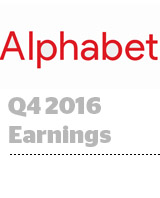Alphabet on Thursday disclosed revenue of more than $26 billion in Q4 2016, a 22% jump over the same period last year and beating industry expectations of $25.2 billion in revenue.
But despite overall revenue growth, the digital ad platform giant’s earnings were undercut by other costs, including a one-time tax charge that pushed its effective tax rate from 16% to 22%, rising traffic acquisition costs (TAC) and new investments in data centers.
Google still represents all but a marginal amount of Alphabet’s revenue. In Q4, Google – which doesn’t break out channels like YouTube, mobile or desktop search – saw revenue grow from $21.2 billion in Q4 2016 to $25.8 billion.
YouTube and mobile remain the engines for Alphabet’s growth, Google CEO Sundar Pichai said during an earnings call with investors. Programmatic ad revenue also “continues to be a strong contributor, reflecting overall advertiser adoption of targeting and programmatic inventory,” he said.
There are headwinds though, many of which have become a constant refrain for Alphabet.
TAC, which Google pays to affiliates to send users to Google or to use Google search as a default, are rising sharply. The company spent $800 million on traffic acquisition in Q4, and the percent of Google ad revenue eaten up by those costs ticked up from 21% to 22%.
Google’s standing in voice-activated search was also a primary concern with investors.
Mark Mahaney, RBC Capital’s managing director who oversees internet investments, said rivals are outselling Google home devices by a wide margin, “which is immaterial now, but in five years what if there’s a new voice search and it isn’t Google in the home?”
Pichai responded that it’s still early days for connected home devices and for the investments necessary to make voice search a major market category. He also pointed to Google’s potential touch points across phones, televisions, cars, desktops and connected devices as a crucial advantage in his vision for Google search AI, compared to competitors that rely on home speaker-type devices for general search (cough, Amazon, cough).
“Someone may ask a question on voice, and then when they pick up their phone later they want continuity,” Pichai said.
Google’s cross-screen access came up again when Pichai was pressed to address YouTube’s recent decision to remove third-party pixels from YouTube and allow search data to inform YouTube buys.
“It’s important to understand users experience YouTube across screens, and I think as part of these changes advertisers will be able to use and get more insights from their campaigns,” Pichai said. “It’s the right direction.”














